Part II: Quality of Light
Last week, we covered the different types, sizes and features of under cabinet fixtures in part one of the DIY Guide to Under Cabinet Kitchen Lighting (READ PART ONE HERE). Now in part two, you'll learn what to look for in a quality under cabinet light fixture and the final important factors you should consider before making a purchase and getting started with your DIY kitchen lighting installation.
If you have tried shopping for a light bulb recently, you know the lighting market is more complex and confusing than ever, with multiple competing technologies (LED, CFL, tungsten, halogen, and others) on the market that each offer different specs, features, and terminology. The market for under cabinet fixtures is fortunately not nearly as complex, but there are still many options available with enormous differences in quality – especially in the quality of light they produce.
What do we mean by “quality of light?” Imagine, if you will, the crisp, clean lighting of a fine art gallery or museum. This is
Too often, consumers will spend thousands of dollars on a new home or kitchen remodel only to undermine their investment with poor quality lighting that casts an unnatural glow on the room and dampens the vibrancy of the space.
There are
Dimmability
Dimmability is an important feature in kitchen lighting. A dimmable fixture provides the versatility of maximum light for when you are actually using the kitchen (such as meal prep, entertaining, cleaning), all the way down to subtle ambient light for evenings or times when the kitchen is not in direct use.
Fully dimmed lights can produce a beautiful, subtle glow that makes your kitchen space easier to navigate at night. And because dimmed LEDs sip only tiny amounts of electricity, they can be left on during the day at negligible expense to provide an inviting warm glow when you get home at night (instead of walking into a pitch black house).
Early LED fixtures did not offer dimming functionality, and those that did struggled to provide the smooth dimming curve of legacy incandescent lighting. Newer models from GE and others at the mid and high end of the market have addressed these problems, and now offer full-range front phase dimming as versatile as any halogen fixture when used with compatible LED dimmers, and leaps and bounds beyond what fluorescents could ever achieve.
If
Brightness
The industry standard unit of measurement for brightness is the lumen, which indicates the total amount of light coming out of a bulb or fixture.
Determining how many lumens you need for your installation depends on the size of your kitchen, what you intend to use the lights for, and personal preference. Dimmable fixtures eliminate the guesswork and are the best way to ensure you are getting the right amount of lumens for every situation since they can always be adjusted to your preference and needs at the time.
Over the past few years, the LED industry has become ensnared in a fierce lumen race; feeding consumers’ assumption that more is better, manufacturers have raced to one-up each other with increasingly brighter models each buying season. Lumens are the most prominent feature you will see called out on most product packaging, but they are only one factor in the quality of light.
Color Temperature
Color temperature is, simply put, a measurement of how warm or cool a light source is.
To understand color temperature, picture the sun shining on a frozen white tundra. This is cool light, and it accentuates the blues of everything it touches. Now picture a Hawaiian sunset. This is warm light, and it brings out the oranges and reds of the environment.
Biologically, humans are wired to respond to cool light with alertness, while
Correlated Color Temperature (CCT) is measured in degrees Kelvin. This is where things can get confusing. The higher the color temperature, the cooler the light. This can seem counterintuitive until you understand the origins of color temperature measurement.
For over a century (and until very recently), standard light bulbs worked by running an electric current through a tungsten filament. The heat from this current caused the filament to glow, producing light. The hotter a filament gets, the cooler the color of its glow. The degrees Kelvin system of color temperature measurement is correlated to the color that a tungsten filament will glow at any given temperature. This is why a 2700 degree Kelvin (2700K) light bulb appears much warmer in hue than a 5000k bulb.
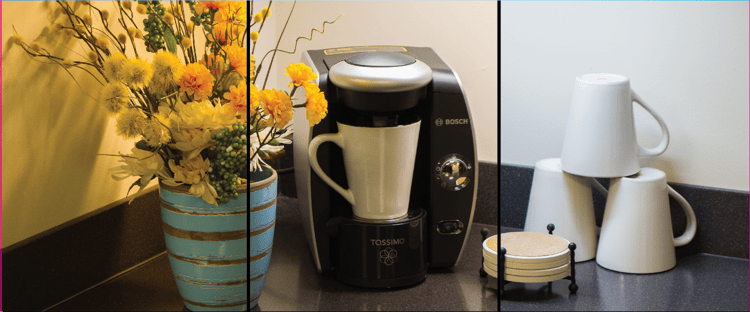
See the difference of UCF Color Temperature: A kitchen counter at 3000K, 4000K and 5000K.
If this is still confusing, consider the example of fire, for which the same principle is true: the blue flame of a blowtorch is a much higher temperature than the warm orange glow of a candle. So remember: the higher the color temperature, the cooler the light.
Some helpful reference points for color temperature:
-
1000K – 1700K: Candlelight
-
2200K: Vintage Edison-style filament bulbs. (For examples, see any hipster restaurant)
-
2700K: Standard 60W Incandescent bulb
-
3500K – 4100K: Overhead fluorescent lighting (found in most office buildings)
-
5000K: “Daylight” LED and Fluorescent Bulbs
-
6500K: High efficiency (“blue-ish”) LEDs
(Note: this color temperature is very rare these days, but was common to early LED lighting products. Some people still associate LED lighting with these harsh blue-hued lights of yore. But don’t worry – you will almost never find 6500K lights in consumer lighting products today). -
10000K: Sunlight at high noon
The list above gives you a sense of the spectrum of color temperatures you might commonly encounter, but in residential LED lighting only two color temperatures matter:
- 2700K – 3000K “Warm White”: This is the color temperature of light produced by a standard 60-watt incandescent bulb. Most Americans grew up with this light in their homes, and it remains the most popular option among North American consumers today.
- 5000K “Daylight”: This color temperature is much cooler and whiter than the warm hue of 2700K. Highly popular in Europe and Latin America, 5000K lighting products are gaining in popularity among American consumers.
Nearly every residential LED lighting product on the market aligns with one of these color temperatures. Most fixtures operate at only one color temperature, so it is important to pay attention to the color temperature listed on the box or product description before buying.
|
|
For kitchen lighting, most consumers prefer 2700K – 3000K “warm white,” as many find the bright white intensity of 5000K to be overwhelming in the evening – when you are most likely to be using your kitchen.
Next generation under cabinet fixtures with selectable color temperatures are expected to hit the market in the latter of half 2016, but for the time being, consumers will have to pick a single color temperature and stick with it.
The worst mistake you can make in kitchen lighting is to mismatch the color temperature of your lighting fixtures. If you have 5000K “daylight” LED bulbs in your ceiling fixture and install 3000K “warm white” under cabinet fixtures, your lighting will clash severely if both are turned on at the same time. If you plan to use only one or the other, mismatched color temperatures will be less of a problem, but it is recommended to stick to a single color temperature throughout your kitchen.
Hot Spots
Lower quality LED under cabinet fixtures tend to use fewer LEDs with wider spacing between each die (light source). The result is an uneven light pattern typified by hot (bright) and cool (dim) spots.
High quality LED under cabinet fixtures use many LEDs, often supplemented with optical diffusion (for example, a diffuser lens), to produce a perfectly uniform light that is free of hot spots. This uniform light also produces only a single shadow.
The difference between a lower quality fixture with hot spots and a higher end product with uniform light distribution may seem subtle, and it is. Most people will not consciously notice or be able to articulate the difference in light quality based on this factor alone; but at an unconscious level, the absence of hot spots will have a big impact on how “clean” the lighting looks and feels in your space.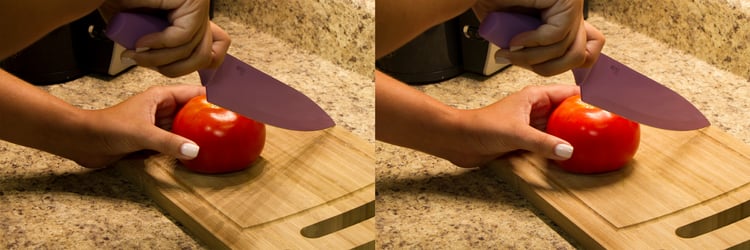
Multiple shadows from a
If usable light to aid with meal preparation is your only goal, then there are many lower cost LED under cabinet fixtures available with moderate hot spotting that will serve you just fine. But if you are looking for a major upgrade to the overall look and feel of your kitchen lighting, consider a mid-market or higher end fixture that provides uniform light distribution free of hot spots.
CRI (Color Rendering Index)
Color rendering index (CRI) is a measurement of color fidelity. In other words, it measures how accurate the color of an object looks under a given light source.
For example, low CRI lighting can make it difficult to distinguish between black and dark navy or brown. For another example, picture your most colorful outfit: now picture it under the fluorescent lighting of an office building (a low CRI of about 60-70). If you were to then walk outside into bright sunlight (the highest possible CRI of 100), the colors would look completely different, with far greater variation and nuance.
Early generation LED products had a relatively low CRI score of about 70. Today the standard is 80, and it is rare to find LED under cabinet fixtures on the market with CRI scores lower than this. Most people are satisfied with 80 CRI, but if you really want to enhance the look of your kitchen, premium fixtures are now available (link to Enbrighten UCF) with CRI scores as high as 98 (nearly perfect).
CRI, while valuable, is an imperfect measurement that can be “gamed” by unscrupulous manufacturers, making it potentially misleading. It is possible for two comparable fixtures from different manufacturers, each with the exact same color temperature and CRI, to produce light that still appears very different when viewed side by side. Discerning consumers should absolutely look for high CRI fixtures, but CRI is only part of the story.
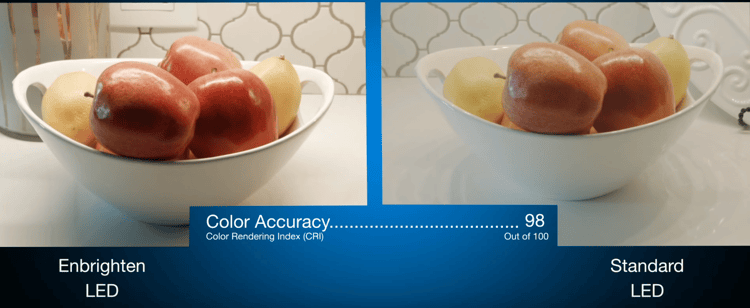
An example of high saturation and high CRI. Enbrighten LEDs vs standard LEDs.
Color Saturation
A more important measurement of how pleasing a light source will be to the naked eye is color saturation. There is not yet a widely adopted measurement for color saturation but LED under cabinet fixtures with high color saturation are typified by high R9 phosphor values. This means the LEDs used in the fixture are “doped” (treated) with a special phosphor additive that enhances the red portion of the color spectrum emitted by that light. The result to the naked eye is that virtually all colors underneath that light will appear more deep, rich, and vibrant.
The best LED under cabinet fixtures will have both a high CRI and high color saturation. When viewed in side-by-side comparison with a standard fixture, the difference in light quality is astounding.
Imagine an old standard definition television and a modern HDTV. The standard definition model looks perfectly nice on its own, but once you see the HD flatscreen in action your standards are forever raised, and you can never go back. Upgrading your kitchen lighting from fluorescent or lower quality LED fixtures to premium LED fixtures with high CRI and high saturation produces similarly extreme results.
Unfortunately, because there is no industry standard way to communicate color saturation to consumers, very few manufacturers pay attention to it, and it is one of the most tragically neglected aspects of residential lighting quality. Only one product line – the GE Enbrighten Premium Under Cabinet Fixture series – currently offers both high CRI and high color saturation at an affordable price point.
Summary
Quality under cabinet fixtures
Here are the factors you should consider before purchasing:
-
How long are the cabinets you want to light?
-
How many fixtures will you need, and what lengths?
-
If you will need multiple fixtures, considerable purchasing linkable models that can be powered and controlled from a single source.
-
Do you want plug-in fixtures that can be easily installed and removed or direct wire fixtures that are more complex to install, but can be powered and operated by a single light switch?
-
Select your favorite color temperature (2700K-3000K, or 5000K) and stay consistent with it throughout your kitchen.
-
Is
dimmability important to you? -
Look for fixtures with at least 80 CRI, but 90+ is ideal.
-
For maximum lighting quality that you can see and feel, look for fixtures with high color saturation.
We hope this guide has been informative and useful. As the world’s largest manufacturer of under cabinet light fixtures, Jasco offers a wide selection of GE branded LED lighting solutions to meet every need and budget.
Browse the entire catalog HERE or shop online at Amazon.com or HomeDepot.com.
RELATED POSTS:
The DIY Guide to Under Cabinet Kitchen Lighting: Part One

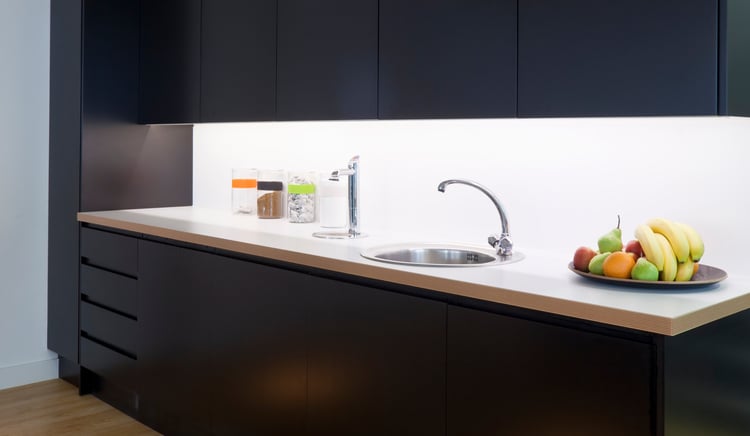
 Kitchen with warm white 3000K light
Kitchen with warm white 3000K light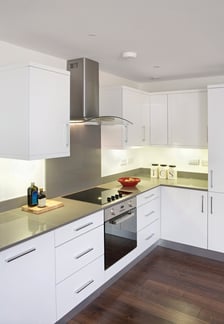 Kitchen with bright white 5000K light
Kitchen with bright white 5000K light